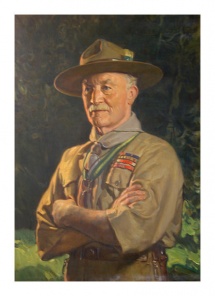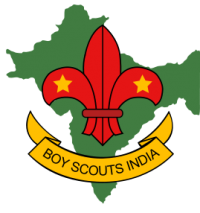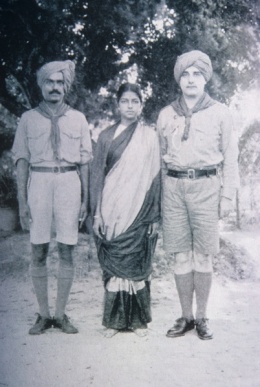Boy Scout Movement and Theosophical Movement: Difference between revisions
(Created page with "'''ARTICLE UNDER CONSTRUCTION'''<br> '''ARTICLE UNDER CONSTRUCTION'''<br> The international '''Scout Movement''' was founded in 1907 by '''Robert Baden-Powell''', a lieutenant...") |
No edit summary |
||
| Line 1: | Line 1: | ||
'''ARTICLE UNDER CONSTRUCTION'''<br> | '''ARTICLE UNDER CONSTRUCTION'''<br> | ||
'''ARTICLE UNDER CONSTRUCTION'''<br> | '''ARTICLE UNDER CONSTRUCTION'''<br> | ||
[[File:Robert Baden-Powell color.jpg|215px|right|thumb|Robert Baden-Powell]] | |||
The international '''Scout Movement''' was founded in 1907 by '''Robert Baden-Powell''', a lieutenant general in the British army. His aim was to provide young people with wholesome activities such as camping and hiking, opportunity for self-development, and training in citizenship, leadership, and brotherhood. Theosophists quickly saw that the Scout Movement shared many of its values, particularly in providing opportunities for youth all over the world to engage peacefully with each other. | The international '''Scout Movement''' was founded in 1907 by '''Robert Baden-Powell''', a lieutenant general in the British army. His aim was to provide young people with wholesome activities such as camping and hiking, opportunity for self-development, and training in citizenship, leadership, and brotherhood. Theosophists quickly saw that the Scout Movement shared many of its values, particularly in providing opportunities for youth all over the world to engage peacefully with each other. | ||
| Line 15: | Line 16: | ||
The first movement of Boy Scouts in India was due indirectly to [[Charles Webster Leadbeater|Mr. C. W. Leadbeater]], who had spoken very highly of the training, and shown General Baden-Powell's book [''Scouting for Boys''] to his private secretary, [[Ernest Wood|Mr. Ernest Wood]]. The result of this was that in 1913, when Mr. Wood became Hon. Secretary of the [[Theosophical Educational Trust|Theosophical Education Trust]], he introduced scouting at the High School at Madanapalle... where the first Troop was started under the leadership of Mr. Deobhankar. About a year later Mr. Wood arranged with Mr. [Frederick Gordon] Pearce, Assistant Commissioner for Boy Scouts in Ceylon, to send a thoroughly trained Scout Master to Madanapalle; the result was the arrival there of Mr. Aryarathna, who very soon trained a really first class Troop. Stimulated by this success, other Troups sprang up in various places.<ref>Hilda Wood, "The Indian Boy Scouts," ''The Messenger'' 9.8 (January, 1922), 190.</ref> | The first movement of Boy Scouts in India was due indirectly to [[Charles Webster Leadbeater|Mr. C. W. Leadbeater]], who had spoken very highly of the training, and shown General Baden-Powell's book [''Scouting for Boys''] to his private secretary, [[Ernest Wood|Mr. Ernest Wood]]. The result of this was that in 1913, when Mr. Wood became Hon. Secretary of the [[Theosophical Educational Trust|Theosophical Education Trust]], he introduced scouting at the High School at Madanapalle... where the first Troop was started under the leadership of Mr. Deobhankar. About a year later Mr. Wood arranged with Mr. [Frederick Gordon] Pearce, Assistant Commissioner for Boy Scouts in Ceylon, to send a thoroughly trained Scout Master to Madanapalle; the result was the arrival there of Mr. Aryarathna, who very soon trained a really first class Troop. Stimulated by this success, other Troups sprang up in various places.<ref>Hilda Wood, "The Indian Boy Scouts," ''The Messenger'' 9.8 (January, 1922), 190.</ref> | ||
</blockquote> | </blockquote> | ||
[[File:Boy Scouts Association in India emblem.png|200px|right|thumb|Emblem of Boy Scouts Association in India]] | |||
She described the many useful contributions of Indian Scouts to society in fighting fires, assisting pilgrims, and finding lost children. They made stretchers made simply of two staves and a turban to carry cholera victims to shelter. "During epidemics of plague, cholera an the like, the scouts are always to the fore, till at last the government and the people called upon the nearest Scout Master whenever help was required."<ref>Wood, 190.</ref> | She described the many useful contributions of Indian Scouts to society in fighting fires, assisting pilgrims, and finding lost children. They made stretchers made simply of two staves and a turban to carry cholera victims to shelter. "During epidemics of plague, cholera an the like, the scouts are always to the fore, till at last the government and the people called upon the nearest Scout Master whenever help was required."<ref>Wood, 190.</ref> | ||
Revision as of 03:03, 9 August 2017
ARTICLE UNDER CONSTRUCTION
ARTICLE UNDER CONSTRUCTION
The international Scout Movement was founded in 1907 by Robert Baden-Powell, a lieutenant general in the British army. His aim was to provide young people with wholesome activities such as camping and hiking, opportunity for self-development, and training in citizenship, leadership, and brotherhood. Theosophists quickly saw that the Scout Movement shared many of its values, particularly in providing opportunities for youth all over the world to engage peacefully with each other.
Dr. Annie Besant, President of the Theosophical Society based in Adyar, Madras, India often said that "there were two great Movements which stood for Universal Brotherhood. One was the Theosophical Society ... And the second, the World Boy Scout Movement."[1]
Scouting in India
Boy Scout troops were established in India as early as 1909 in Allahabad, but were open only to boys of English and Anglo-Indian families.[2]
Ernest Wood and Indian Scouting
Hilda Wood wrote a detailed account of the early days of the Scout Movement in India.
The first movement of Boy Scouts in India was due indirectly to Mr. C. W. Leadbeater, who had spoken very highly of the training, and shown General Baden-Powell's book [Scouting for Boys] to his private secretary, Mr. Ernest Wood. The result of this was that in 1913, when Mr. Wood became Hon. Secretary of the Theosophical Education Trust, he introduced scouting at the High School at Madanapalle... where the first Troop was started under the leadership of Mr. Deobhankar. About a year later Mr. Wood arranged with Mr. [Frederick Gordon] Pearce, Assistant Commissioner for Boy Scouts in Ceylon, to send a thoroughly trained Scout Master to Madanapalle; the result was the arrival there of Mr. Aryarathna, who very soon trained a really first class Troop. Stimulated by this success, other Troups sprang up in various places.[3]
She described the many useful contributions of Indian Scouts to society in fighting fires, assisting pilgrims, and finding lost children. They made stretchers made simply of two staves and a turban to carry cholera victims to shelter. "During epidemics of plague, cholera an the like, the scouts are always to the fore, till at last the government and the people called upon the nearest Scout Master whenever help was required."[4]
Annie Besant and Indian Scouting
In 1918, Dr. Annie Besant organized the Indian Boy Scout Movement, with the aid of Mr. Pearce and Shri M. V. Venkateshwaran.
Lord Pentland, the then Governor of Madras [now Chennai], organized another Association confined to English and Anglo-Indian boys. These two organizations were popularly known as Besant Scouts and Pentland Scouts. When Lord Baden-Powell came to India in 1921 Dr. Besant, who liked him immensely, expressed her willingness to help a union in every possible way. One particular obstacle was that the Pentland Scouts insisted that even if the Indian Scouts joined them they should ware the Scout hat and shoes, whereas the Besant Scouts insisted on wearing the green turban and be permitted to go barefoot if they so desired. Baden-Powell did not consider that the Scout hat ... was anything essential as a part of the equipment of a Scout and readily agreed to the use of the turban. The amalgamation of the two organizations then took place, and Dr. Besant was appointed Honorary Commissioner for All-India of the Boy Scouts Association.[5]
Dr. Besant was given the Silver Wolf Award by Lord Baden-Powell in 1932. It is the highest honor offered by the Scout Movement. C. Jinarājadāsa, who worked closely with Mrs. Besant for many years, wrote:
To identify herself more closely with the Scout Movement, she had woven for her a silk sari of khaki colour, with a green border, and a turban in khaki on which was placed the Scout emblem. Whenever in her later years she was present at a Scout Rally she was always dressed in this Scout uniform.[6]
She wrote a message to the scouts at Adyar in 1929:
If I had a dozen sons – I have only one – I would send them all into the Scout Movement, as soon as they could enter its lowest grade. And I would send the daughters into the Girl Guides… Now do you think that I could say anything stronger than that, as a recommendation to you, who read this, in the way of advice as to joining the Scouts or the Guides…
Perhaps you may like to know that I took the Scout's pledge from our Chief Scout, Sir Robert Baden-Powell, here in Madras, at a big Scout Rally.[7]
Two years later she wrote.
Looking back over a long life, now that I am more than eighty years of age… I am inclined to say that I consider the part I took in the introduction of Indian boys and youths into the Scout Movement was one of the most useful steps in my life. It bought together the young of the two Nations and founded, I hope and believe, many friendships which will last after the two go out into the larger world… Games and athletic exercises are among the most pleasant and potent ways of forming lasting friendships..[8]
George Arundale and Indian Scouting
During his years as Principal of Central Hindu College, George S. Arundale became a Scout Officer, and he continued his work with the Scouts well into his term as president of the Theosophical Society, serving as Vice-President of the Provincial Council of the Boy Scout Association in the Madras Presidency.[9]
By 1933 when he began his term as TS president, the Scout Movement had expanded into at least 32 countries, with a total of 2,251,726 Scouts.[10]
In 1935 he delivered a radio address on the Madras Corporation Broadcasting Station, describing the benefits of the Scout Movement to India:
If India is to achieve material well-being, if she is to become, within the great Commonwealth of Nations to which she belongs, a potent force or peace and international comradeship, she must have good citizens - boys and girls, men and women; for citizenship begins at birth, first with rights, but soon with duties.
The Scout and Girl Guide Movements exist to produce good citizens...[11]
Boy Scouts’ Hobby Club
The Boy Scouts' Hobby Club formed in 1923 at Mizar Lodge in Conjeeveram [now Kanchipuram] in south India. The objective was to encourage scouts worldwide to engage in correspondence to strengthen a sense of brotherhood by discussing hobbies. All members received the international magazine of the club, Brotherhood.[12]
Scouting in Sri Lanka
Scout troupes were established at several schools operated by the Buddhist Theosophical Society:
- 1913 – Dharmaraja College, Kandy
- 1914 – Mahinda College, Galle
- 1916 – Ananda College, Colombo
Scouting in United States
THIS SECTION UNDER CONSTRUCTION
THIS SECTION UNDER CONSTRUCTION
The headquarters of the Theosophical Society in America sponsored a scout troop in the 1930s. Sidney A. Cook.....
Herbert A. Kern, Sr. was chairman of the Southwest District of the Boy Scouts of America, Chicago.
Notes
- ↑ C. Jinarajadasa, "Dr. Besant and the Scout Movement" The Theosophist 69 (November, 1947), 157.
- ↑ Bharat Guides and Scouts web page.
- ↑ Hilda Wood, "The Indian Boy Scouts," The Messenger 9.8 (January, 1922), 190.
- ↑ Wood, 190.
- ↑ C. Jinarajadasa, "Dr. Besant and the Scout Movement" The Theosophist 69 (November, 1947), 156-157.
- ↑ C. Jinarajadasa, "Dr. Besant and the Scout Movement" The Theosophist 69 (November, 1947), 158.
- ↑ Annie Besant, "Annie Besant – Scout" The Theosophist 64 (October, 1942), 51. Reprint of a message delivered March 7, 1929.
- ↑ Annie Besant, "A Message to Indian Scouts" The Theosophist 52 (March, 1931), 420b.
- ↑ George S. Arundale "How the Boy Scout Movement Helps the World" The Theosophist 56 (April 1935), 65.
- ↑ Anonymous, "Boy Scouts: The Growth of the Movement" The Theosophist 57 (January, 1936), 381.
- ↑ Arundale, 65.
- ↑ S. R. Krishnan, "The Boy Scouts' Hobby Club" The Theosophist 44 (February, 1923), 558.


